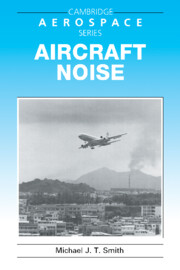Book contents
- Frontmatter
- Contents
- Preface
- Acknowledgments
- 1 Human reaction to aircraft noise
- 2 Action against aircraft noise
- 3 Aircraft noise sources
- 4 Power-plant noise control
- 5 Concorde – a special case
- 6 Noise data acquisition and presentation
- 7 Aircraft noise prediction
- 8 Prospects for the future
- 9 Review
- Appendices
- References
- Index
5 - Concorde – a special case
Published online by Cambridge University Press: 06 November 2009
- Frontmatter
- Contents
- Preface
- Acknowledgments
- 1 Human reaction to aircraft noise
- 2 Action against aircraft noise
- 3 Aircraft noise sources
- 4 Power-plant noise control
- 5 Concorde – a special case
- 6 Noise data acquisition and presentation
- 7 Aircraft noise prediction
- 8 Prospects for the future
- 9 Review
- Appendices
- References
- Index
Summary
Conceived as the transport of the future, in an era when fuel accounted for less than 10% of airline costs, the Concorde (Fig. 5.1) was a special case by any yardstick. Capable of flying at Mach 2, or over 2000 kph, for distances of about 6500 km without in-flight refuelling, it outpaces most and outsustains all the world's military aircraft. In fact, in mid-1987, by which time the Concorde had carried its millionth passenger, it had also operated at supersonic speeds for more than twice the time of the whole of the Western world's military fleet put together.
Its commercial failure – only sixteen production-standard aircraft were manufactured – was entirely a function of the change in the world economy in the 1970s. With the price of aviation fuel rising almost tenfold in a decade, there was a sustained drive to reduce the fuel consumption of all aircraft engines. Accordingly, concerted efforts to alter the design of subsonic engine components, allied to the emergence of the turbofan engine, meant that the Concorde's subsonic contemporaries were achieving up to 40% better fuel consumption than their forebears. The Middle East war of the early 1970s, which sparked the alarming increases in the price of oil shown in Figure 5.2, only served to emphasise the Concorde's uncompetitiveness, for the 40% improvement in fuel consumption only softened the blow to the airlines, which still found fuel to be 30% of their overall operating costs and would have found the Concorde even more consumptive. Over half the Concorde's weight is taken up by fuel. Hence, it is hardly surprising that the production run was limited.
- Type
- Chapter
- Information
- Aircraft Noise , pp. 153 - 175Publisher: Cambridge University PressPrint publication year: 1989



